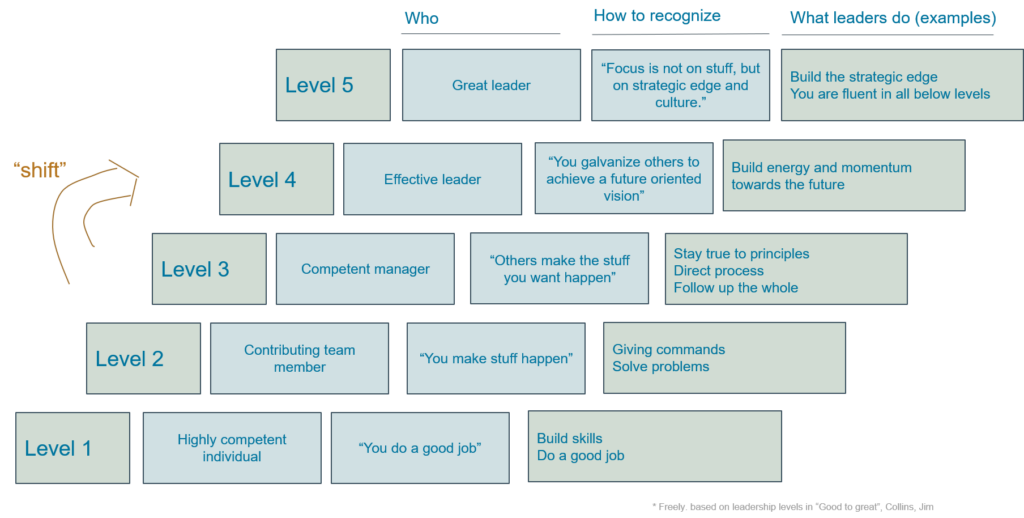4. Move decisions to the information – shift your leadership style

Why it matters
Having established a team-based organization, the next key is putting the teams to use. One way to generate both faster decision speed and unlock engagement is by decentralizing decision making (shifting responsibility) to where the information is.
What people often miss is that this also requires a shift in leadership behavior, from command and control to long term leadership (building the system/environment that produces results). If you are convinced that this has nothing to do with you (it’s “about them ” for the most part), you aren’t mentally ready yet for this shift.
This delusion is infamously known as “the law of the lid”, referring to leaders who are oblivious to their own doing in hindering the growth of their organization.
A better mental goal is to be fluent leading at the level that the organization needs, in order to grow.
Eyes on – hands off
The most common misconception about shifting leadership style is that the shift is not about stepping away completely. It’s not about hiding behind the teams. It’s also not about controlling every detail. It is more about giving responsibility within boundaries, being present, and solving problems but using a coaching approach. David “Turn the ship around” Marquet, an ex-nuclear submarine commander, succinctly paraphrased this as “eyes on, hands off”.
How it works
Putting self-organizing Agile teams to use means shifting the responsibility for “how to” achieve a certain mission to the team. This also means shifting improvement responsibility to the teams that do the work.
For example, at the startup phase, a typical entrepreneur is needed, someone who can make things happen. Then, as the organization grows and improves, a leadership shift is required. If you stay as the “go to” guy or the “answer man”, your responsibility never shifts. Your peers never learn to think for themselves.
As a starting point to illustrate levels of leadership, let’s use the levels described by Collins (below). A startup company typically needs to shift from Level 2 style leadership to Level 3 (or above) to continue its development.
The leadership shift

Critique: These levels are based on observations of the top 11 performing companies in Fortune 500 out of 1,435 candidate companies,. 2 of the 11 later went bankrupt during the financial crisis. We use Jim Collins’ leadership levels to illustrate the shift in leadership since it is fairly well known, and because it is empirically based (compared to purely theoretical models without validation in real world companies or lack of empirical studies thereof)
What is important to recognize is that each leadership role comes with a set of responsibilities, and a set of opportunities. Becoming Agile in your leadership is another way of saying that you are fluent across levels, you are adapting your style based on the organizations current maturity and what it needs in order to develop. It’s a lifelong learning journey.
You are probably thinking, “I get this”. Of course you do. The hard part remains – adapting your leadership behavior in daily practice. And sticking with it, under pressure. That’s when you know you have what it takes.
Practice – Lead using powerful questions
One good habit that shifts your leadership style is to lead using powerful questions. This engages your co-workers to think for themselves and to take responsibility for their actions. (“eyes on, hands off”) Schedule a weekly walk in at a fixed time each week (gemba walks) and practice leading the gemba walks, using these three questions:
- What is the current situation?
- What should be happening?
- What is the first step?
The trick is to listen more than you talk. If you do, you will learn a lot. This is because your mind is actively listening instead of preparing the answer.
Another example where you could practice applying “lead using powerful questions” would be during your operational management meetings. If you find yourself caught in long and detailed discussions, the better approach is often to short cut it by simply asking a question to the team that first observed the problem, “how would you solve it?” and then support them in their effort.
The elegance of this approach is that you need to process less information to reach a decision; responsibility to act isn’t shifted back to the leader but stays with the team; and the counter measure is very likely far more surgical than “broad and heavy”.
References
Good to great, Jim Collins, HarperBusiness, 2001
Leading through intent, David Marquet
Ladder of leadership, David Marquet
The New New Product Development Game, Hirotaka Takeuchi and Ikujiro Nonaka, 1986